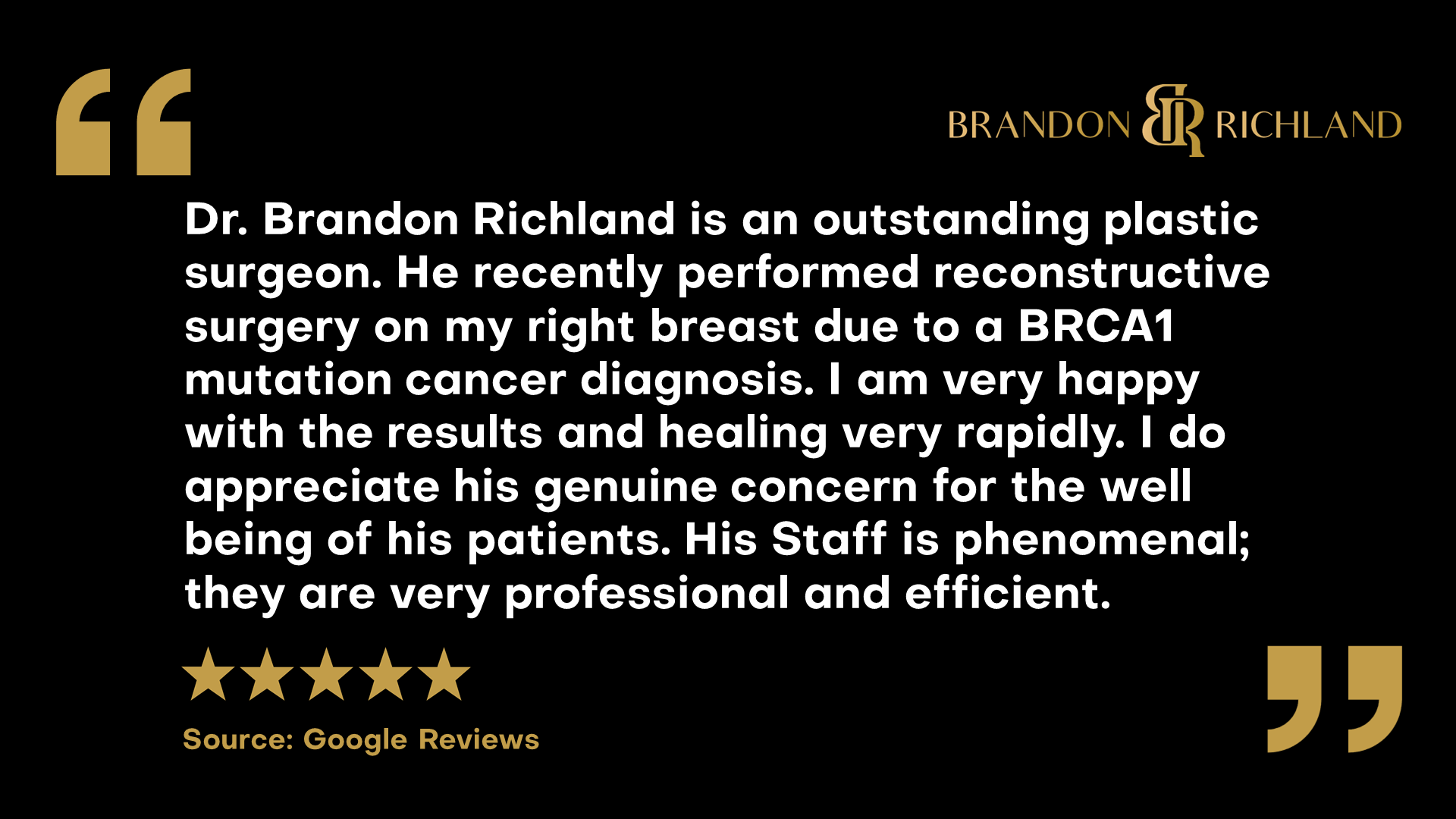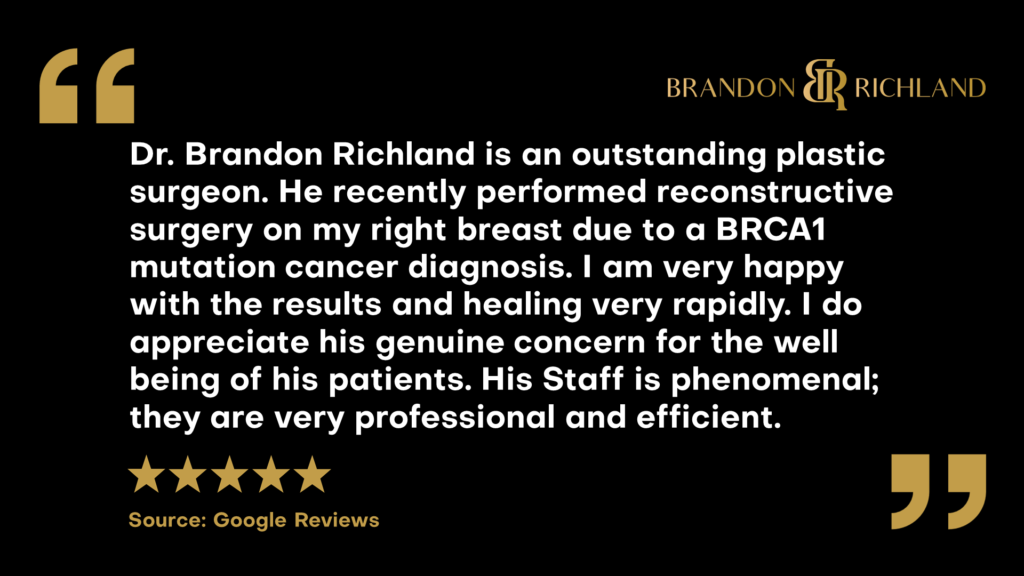Published by Dr. Brandon Richland, MD

“Dr. Brandon Richland is an outstanding plastic surgeon. He recently performed reconstructive surgery on my right breast due to a BRCA1 mutation cancer diagnosis. I am very happy with the results and healing very rapidly. I do appreciate his genuine concern for the well being of his patients. His Staff is phenomenal; they are very professional and efficient.”
Read the full Google Review here.
Understanding Breast Reconstruction
Breast reconstruction is a surgical procedure to restore the appearance of a breast for someone who has had a mastectomy. This section explores the types of reconstruction surgery, the timing of the procedure, and considerations when choosing a plastic surgeon.
Types of Reconstruction Surgery
There are two main categories of breast reconstruction surgery:
- Implant Reconstruction: This involves inserting an implant filled with silicone gel or saline (saltwater) beneath the skin or muscle of the chest to recreate the breast mound.
- Tissue Reconstruction: Also known as autologous or flap reconstruction, this method uses the patient’s own tissue from another part of the body to form a new breast.
Each method has different approaches and considerations. For instance, tissue reconstruction might involve tissue from the abdomen or back, depending on individual circumstances.
Breast Reconstruction Timing
Patients typically have two timing options for breast reconstruction:
- Immediate Reconstruction: The reconstruction begins at the same time as the mastectomy.
- Delayed Reconstruction: The reconstruction takes place in a separate operation, sometime after the mastectomy.
The choice between immediate and delayed reconstruction depends on various factors, including the patient’s medical condition, cancer treatment plan, and personal preferences.
Choosing a Plastic Surgeon
Selecting a plastic surgeon is a crucial step in the breast reconstruction process. Patients should consider:
- The surgeon’s experience and specialization in breast reconstruction.
- Their comfort level with the surgeon’s approach and the information provided about different options.
Communication between the patient and the plastic surgeon is essential to set realistic expectations and to understand the risks and benefits involved with each type of reconstruction.
Reconstruction Techniques and Considerations
Reconstruction after breast cancer involves several techniques tailored to meet the individual’s needs and preferences. The reconstructive options mainly include the use of implants or autologous tissue and often consider the patient’s body type, health status, and desired outcome.
Implants and Expander
Breast Implants are commonly made from either saline or silicone and are used to reshape the breast following a mastectomy. The process may also involve the use of a tissue expander, which helps stretch the skin and muscle to make room for a future implant.
- Saline implants: These are filled with sterile saltwater. They are inserted empty and then filled to the desired volume.
- Silicone implants: Known for a more natural feel, they come pre-filled with silicone gel.
The patient will discuss with their surgeon the size, shape, and type of implant that best suits their body and symmetry with the healthy breast. Post-surgery, scars are typically hidden and fade over time, but their visibility will vary among individuals.
Flap Procedures
Flap Surgery, another common method of breast reconstruction, involves taking live tissue from different parts of the body to create a new breast mound. The two frequently used techniques are:
- DIEP flap: Tissue from the lower abdomen, including skin, fat, and blood vessels, is used but not muscles, helping to preserve abdominal strength.
- TUG flap: Tissue, including skin, fat, muscle, and blood vessels, is taken from the upper inner thigh.
Both methods involve microsurgery to connect the blood vessels of the transferred tissue to the chest’s blood vessels. The choice of flap depends on the patient’s body type, the volume of available tissue, and the desired outcome. Flap procedures can result in more natural-looking breasts and have the benefit of reducing fat in the area where the tissue was taken.
Nipple and Areola Reconstruction
Nipple Reconstruction is a procedure to rebuild the nipple and areola after breast reconstruction. Techniques may include:
- Skin grafts from other body areas.
- Local flap techniques, where small pieces of skin are folded to create a new nipple.
Additionally, medical tattooing can be used to add color to the nipple area and create the appearance of an areola. The reconstructed nipple and areola aim to closely match the natural breast in size, shape, and position to achieve symmetry.
The reconstructive process requires careful planning between the patient and their surgeon, considering factors such as cancer treatment history, current health, and aesthetic goals.
Risks and Recovery Process
Breast reconstruction is a significant procedure with its set of risks and a varied recovery journey. Understanding the potential complications and the process of healing is crucial for anyone considering this surgery, as is recognizing when one can gradually return to their everyday activities.
Potential Complications
Complications after breast reconstruction can range from minor side effects to more severe issues. Here are some of the most common:
- Infection: Infections at the surgery site may occur, requiring antibiotics or additional treatment.
- Blood Clots: The risk of developing blood clots in the legs or lungs is present after any surgery.
- Fluid Build-up: Swelling and pain can result from fluid accumulation in the breast or donor tissue site.
- Tissue Death (Necrosis): There’s a chance that the transplanted tissue might not survive, leading to further procedures.
- Loss of Sensation: Some patients may experience reduced or total loss of sensation in the breast area.
- Capsular Contracture: The formation of scar tissue around the implant can cause discomfort and require additional surgery.
Healing and Aftercare
The healing process is as important as the surgery itself:
- Wound Healing: Patients should follow their surgeon’s instructions to care for incisions to minimize scarring.
- Comfort: Pain relief will be managed with medication, and drains may be placed to remove excess fluids.
- Radiation Therapy Effects: If radiation therapy is part of treatment, it can affect wound healing and skin elasticity.
A detailed aftercare plan typically includes:
- Regular follow-up visits.
- Monitoring for complications.
- Guidance on activity levels and movements to aid in recovery.
Returning to Normal Activities
Recovering from breast reconstruction varies, but key points include:
- Activity Levels: Generally, patients can resume light activities within a week; however, full return to normal activities, including exercise, may take several weeks to months.
- Sensation: Recovery of sensation, if it returns, can take up to a year after surgery.
- Work: Depending on the nature of the job, patients can often return to work within 3 to 6 weeks.
It’s important to maintain regular communication with healthcare providers throughout recovery to ensure any complications are addressed promptly and that recovery is progressing well.
Insurance and Cost Considerations
When considering breast reconstruction after cancer, patients should be mindful of the associated costs and insurance coverage options. Under the Women’s Health and Cancer Rights Act (WHCRA) of 1998, if a woman’s health insurance plan covers mastectomy, it is also required to cover all stages of breast reconstruction. This includes:
- Reconstruction surgery of the breast on which the mastectomy has been performed.
- Surgery and reconstruction of the other breast to produce a symmetrical appearance.
- Prostheses and treatment of physical complications at all stages of the mastectomy, including lymphedema.
It’s important for patients to check with their insurance provider to understand the specifics of their coverage. Insurance plans can differ widely, and there may be certain conditions and prerequisites for coverage. For example, some insurance plans might only cover certain types of reconstruction surgeries or specific plastic surgeons.
Patients are advised to consider the following potential costs when planning for breast reconstruction:
- Surgeon’s fee: This varies by procedure and surgeon.
- Hospital or surgical facility costs: Includes the cost for the location where the surgery will take place.
- Anesthesia fees: For the patient’s comfort during the procedure.
- Medical tests: Preoperative tests may be necessary.
- Post-surgery garments: Special garments may be needed post-operation.
- Prescriptions: For medication required during recovery.
- Follow-up care: Any additional procedures or doctor visits.
Most insurance providers in the United States are required to include breast reconstruction in their coverage, but some plans might only cover a part of the total cost. Additionally, immediate reconstruction at the time of mastectomy or delayed reconstruction can be covered by Medicare, but specifics can vary. Patients should consult with their healthcare provider and insurance company to select the most appropriate timing and type of reconstruction surgery, as well as to ensure a clear understanding of the covered benefits.
Emotional and Psychological Impact
Breast reconstruction after cancer plays a significant role in navigating the complex emotions and psychological challenges that individuals face. For many, the journey involves reconciling changes to one’s body with their sense of self and seeking support systems that can provide empathy and understanding.
Body Image and Self-Esteem
After a mastectomy, individuals often experience a profound change in their physical appearance, which can profoundly affect their body image and self-esteem. Breast reconstruction offers an opportunity for women and men to restore their body shape, which may help in regaining confidence in their appearance. However, it is important to note that even after reconstruction, changes in breast sensation and the presence of scar tissue can be a reminder of their experience with cancer. For some, tattooing around the reconstructed breast or getting a nipple tattoo can help to improve the appearance of the breast and provide a sense of closure, but the decision is highly personal.
- Breast Sensation: Often diminished post-reconstruction; a variable outcome.
- Scarring: Can range from minimal to more extensive; impacts appearance.
- Tattooing: Utilized for creating a nipple or areola with the aim of improving cosmetic results.
Support and Resources
Reconstructive surgery and its aftermath are not journeyed alone. Support from health professionals, counselors, support groups, and one’s personal network is crucial. Access to resources such as information about breast prostheses and options for those who opt not to undergo reconstruction are vital. For individuals concerned about complications, understanding the risks such as the development of anaplastic large cell lymphoma (ALCL), a rare cancer associated with certain types of breast implants, is part of making informed decisions about their care. Screening for potential issues remains an important part of post-reconstruction care.
- Support Groups: Spaces to share experiences and receive understanding from others in similar situations.
- Breast Prostheses: An alternative to reconstruction for those seeking to maintain breast shape without surgery.
- Screening: Regular follow-up care to monitor for complications or recurrence.
Accessibility to these resources ensures that individuals can face the emotional and psychological challenges with comprehensive support, helping them to heal both physically and emotionally.
Schedule Your First-Class Cosmetic Consultation with Dr. Brandon Richland, MD
Contact Dr. Richland today by visiting RichlandMD.com, scheduling a cosmetic consultation, or by calling 714-844-0398 or 949-997-2958 directly.











